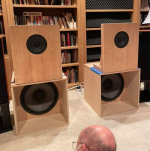It's important to note (again) that the acoustic phase alignment corresponds to the Co-ax baffle positioned directly above the H-frame opening.
Attachments
Last edited:
Dear Dave
Wow, the measurements look impressive, nice work, can only imagine how well this sounds! You guys are having all the fun!
Curious: is this using the aluminum tweeter diaphragm? If so, I wonder if the crossover would need adjustment if Radian's Truextent beryllium diaphragm were used?
Greetings from Switzerland, David.
Wow, the measurements look impressive, nice work, can only imagine how well this sounds! You guys are having all the fun!
Curious: is this using the aluminum tweeter diaphragm? If so, I wonder if the crossover would need adjustment if Radian's Truextent beryllium diaphragm were used?
Greetings from Switzerland, David.
Hello David,
I am pretty sure that Terry's Radians are aluminum. Next time I talk with him I'll confirm that.
These are the only 5208c drivers that I have experienced. I don't know how the beryllium models differ in performance.
The Radian Audio website seems to link to the same datasheet for either aluminum or beryllium. 😕
I am pretty sure that Terry's Radians are aluminum. Next time I talk with him I'll confirm that.
These are the only 5208c drivers that I have experienced. I don't know how the beryllium models differ in performance.
The Radian Audio website seems to link to the same datasheet for either aluminum or beryllium. 😕
Dear Dave
Thanks so much! You're right, I haven't been able to find another spec sheet on the beryllium version either. Judging from experience, frequency response tends to be very similar up to the extended treble, where a beryllium appears to roll off, but then, looking at a waterfall plot, it turns out what's "louder" in the aluminum versions is severe dome breakup. So if anything, the beryllium might need more of a lift above 10k or higher, not less - again, in my experience. In those instances where I could listen to direct comparisons (doesn't include the 8" coaxial discussed here), this difference is audible: the aluminum seems "livelier" at first, but sounds "annoying" in comparison after a short while.
Greetings from Switzerland, David.
Thanks so much! You're right, I haven't been able to find another spec sheet on the beryllium version either. Judging from experience, frequency response tends to be very similar up to the extended treble, where a beryllium appears to roll off, but then, looking at a waterfall plot, it turns out what's "louder" in the aluminum versions is severe dome breakup. So if anything, the beryllium might need more of a lift above 10k or higher, not less - again, in my experience. In those instances where I could listen to direct comparisons (doesn't include the 8" coaxial discussed here), this difference is audible: the aluminum seems "livelier" at first, but sounds "annoying" in comparison after a short while.
Greetings from Switzerland, David.
Hi Dave R,
What sort of amplification is need for this?
Can it be driven both by a single amplifier with low wattage?
Thanks
JoeyGS
What sort of amplification is need for this?
Can it be driven both by a single amplifier with low wattage?
Thanks
JoeyGS
Hello Joey,Hi Dave R,
What sort of amplification is need for this?
Can it be driven both by a single amplifier with low wattage?
Thanks
JoeyGS
My SET KT88 amp drives TerryO's full 3 way system (described in post #80) very well. That amp has about 6-8 Watts max output in triode mode.
The impedance load is fairly easy for tubes.
Last edited:
Thanks Dave RHello Joey,
My SET KT88 amp drives TerryO's full 3 way system (described in post #80) very well. That amp has about 6-8 Watts max output in triode mode.
The impedance load is fairly easy for tubes.
- Home
- Loudspeakers
- Multi-Way
- Radian 5208c coaxial project
